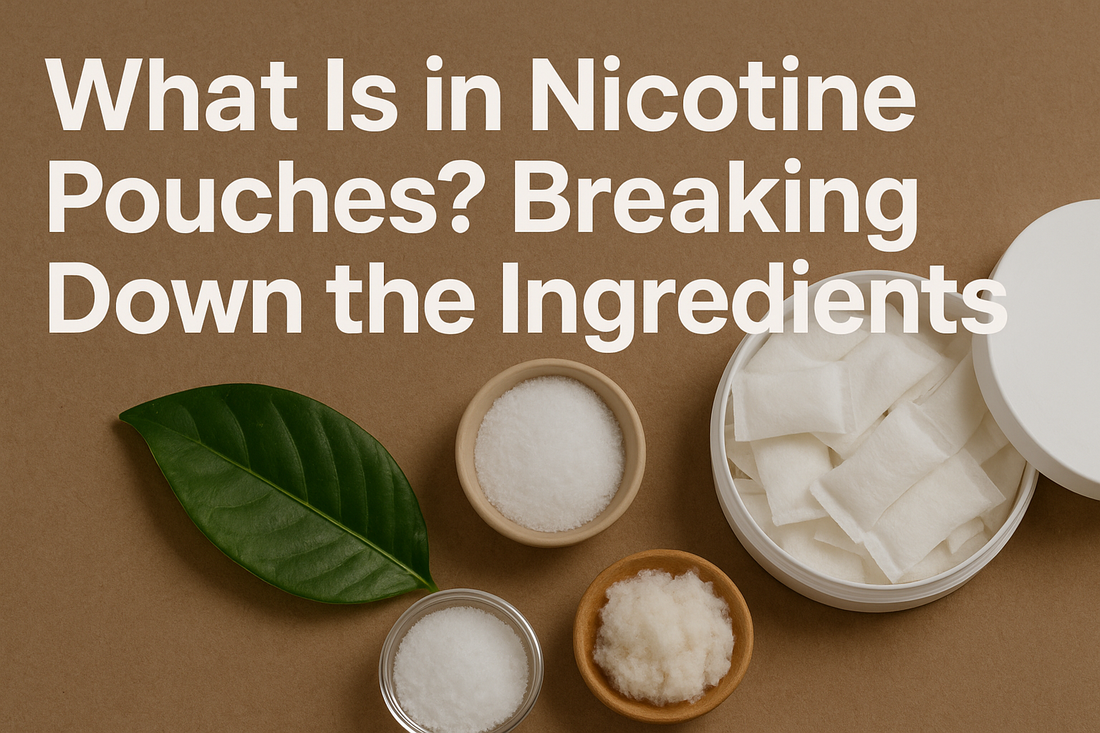
What Is in Nicotine Pouches? Breaking Down the Ingredients
Understanding what goes into the products you use is fundamental to making informed decisions about your health and lifestyle choices. When it comes to nicotine pouches, ingredient transparency has become increasingly important as consumers seek clean, well-formulated alternatives that align with their quality expectations. This comprehensive breakdown explores every component found in modern nicotine pouches, explaining their purposes and sources.
The Foundation: Understanding Modern Formulations
What are nicotine pouches at their core? They are carefully engineered products containing a precise blend of pharmaceutical-grade nicotine, plant-based fillers, natural and artificial flavoring agents, pH adjusters, and moisture-control substances. Each ingredient serves a specific purpose in creating the optimal user experience while maintaining product stability and safety.
The evolution of nicotine pouch formulations reflects advances in food science, pharmaceutical development, and consumer product engineering. Modern manufacturers like Killa and Pablo invest heavily in ingredient research and optimization to create products that deliver consistent satisfaction while meeting the highest quality standards.
Understanding how do nicotine pouches work requires examining how these ingredients interact to create the absorption and delivery mechanism that makes pouches effective. The synergy between components ensures optimal nicotine release while maintaining comfort and flavor throughout the usage period.
Pharmaceutical-Grade Nicotine: The Active Ingredient
The primary active ingredient in quality pouches is pharmaceutical-grade nicotine, which undergoes extensive purification processes to remove impurities and ensure consistent potency. This refined nicotine is derived from tobacco plants but processed to eliminate tobacco-specific compounds and contaminants.
Pharmaceutical-grade nicotine meets strict purity standards that exceed those required for basic consumer products. The purification process removes alkaloids, residual pesticides, and other compounds that might be present in less refined nicotine sources, resulting in a clean, consistent active ingredient.
Premium manufacturers source their nicotine from certified suppliers who provide detailed certificates of analysis documenting purity levels, potency accuracy, and absence of contaminants. This documentation ensures that every batch meets specified quality standards and provides predictable user experiences.
Plant-Based Fillers and Bulk Agents
What is in nicotine pouches beyond nicotine includes carefully selected plant-based fillers that provide bulk, texture, and structural integrity. Common fillers include microcrystalline cellulose, which is derived from plant cellulose and serves as an inert carrier that doesn't affect nicotine absorption.
These fillers are chosen for their ability to maintain proper moisture levels, provide comfortable texture, and support controlled release of the active ingredients. They must be food-grade materials that are safe for oral contact and don't interfere with the intended absorption process.
Salt compounds, typically sodium chloride or sodium carbonate, serve multiple functions including pH adjustment, moisture control, and enhanced nicotine absorption. The specific salts used are food-grade materials commonly found in oral care products and food applications.
Natural and Artificial Flavoring Systems
Flavor development represents one of the most sophisticated aspects of modern pouch formulation. Premium products incorporate complex flavoring systems that provide immediate taste satisfaction while evolving throughout the usage period to prevent flavor fatigue.
Natural flavoring agents are derived from botanical sources and provide authentic taste profiles that appeal to users seeking clean ingredient lists. These natural flavors undergo processing and concentration to achieve the intensity needed for effective delivery in pouch format.
Artificial flavoring agents complement natural options by providing consistency, intensity, and flavor profiles that aren't readily achievable through natural sources alone. These synthetic compounds are identical to natural flavors at the molecular level and undergo the same safety testing as their natural counterparts.
pH Adjustment and Optimization Compounds
pH control plays a crucial role in optimizing nicotine absorption and user comfort. Manufacturers use food-grade acids and bases to achieve optimal pH levels that enhance bioavailability while maintaining oral comfort during use.
Common pH adjusters include citric acid, which provides slight acidity that can enhance nicotine absorption, and sodium carbonate, which provides alkalinity for the same purpose. The specific pH target depends on the formulation goals and desired user experience characteristics.
The pH optimization process requires careful balancing to achieve effective nicotine delivery without creating discomfort or affecting the flavor profile. Premium manufacturers conduct extensive testing to find the optimal pH range for each specific formulation.
Moisture Control and Stabilization Agents
Proper moisture content is essential for pouch activation and optimal user experience. Moisture control agents help maintain the ideal hydration level that ensures reliable activation while preventing excessive wetness or dryness that could affect performance.
Humectants like glycerol help retain moisture and prevent pouches from drying out during storage. These compounds are commonly used in food and pharmaceutical applications and are well-established as safe for oral contact.
Stabilization agents prevent ingredient separation and maintain consistent distribution throughout the pouch contents. These compounds ensure that each pouch delivers the same experience regardless of storage conditions or time since manufacture.
Sweetening and Taste Enhancement
Many formulations include sweetening agents that enhance flavor appeal and provide pleasant taste experiences. These sweeteners are typically non-nutritive options like sucralose or acesulfame potassium that provide sweetness without contributing calories or affecting blood sugar.
The sweetening systems used in premium pouches are carefully calibrated to enhance rather than overpower the primary flavor profiles. The goal is creating balanced taste experiences that remain pleasant throughout the entire usage period.
Natural sweetening options like stevia extracts are increasingly popular in premium formulations, providing sweetness through plant-derived compounds that appeal to consumers seeking natural ingredient lists.
Binding and Structural Agents
The physical integrity of pouches depends on binding agents that hold the contents together while allowing proper nicotine release. These agents must provide structural stability without interfering with the absorption process.
Hydroxypropyl cellulose and similar compounds serve as binding agents that create cohesive pouch contents while maintaining porosity for optimal nicotine delivery. These materials are derived from plant sources and are commonly used in pharmaceutical and food applications.
The binding system must balance structural integrity with release characteristics, ensuring that pouches maintain their form during use while allowing efficient nicotine absorption through oral tissues.
Quality Control and Purity Standards
Premium manufacturers implement comprehensive quality control processes that verify ingredient purity, potency accuracy, and absence of contaminants. These processes often exceed regulatory requirements and provide additional assurance of product quality.
Incoming ingredient testing verifies that all components meet specified purity standards before being incorporated into final products. This testing includes verification of identity, potency, and absence of unwanted contaminants or adulterants.
Final product testing confirms that the finished pouches meet all specifications for nicotine content, moisture levels, pH balance, and microbiological safety. This comprehensive testing ensures consistent quality across all production batches.
Manufacturing Process Impact on Ingredients
The manufacturing process itself can affect ingredient quality and final product characteristics. Premium manufacturers use controlled environments, precision equipment, and validated processes that preserve ingredient integrity throughout production.
Temperature and humidity control during manufacturing prevents ingredient degradation and ensures optimal mixing and distribution. These environmental controls are particularly important for maintaining the stability of sensitive flavoring compounds and nicotine.
Mixing and blending processes must achieve uniform distribution while avoiding excessive processing that could affect ingredient quality. Advanced manufacturing equipment enables precise control over these critical process parameters.
Regulatory Compliance and Safety Standards
All ingredients used in quality nicotine pouches must comply with food contact regulations and safety standards established by relevant authorities. These standards ensure that all components are safe for oral contact and intended use.
The regulatory framework varies between countries, but premium manufacturers typically formulate products to meet the most stringent international standards. This approach ensures broad market acceptance and provides additional safety assurance.
Ingredient documentation and traceability systems enable manufacturers to track every component from source to final product, providing accountability and enabling rapid response to any quality concerns.
Innovation in Ingredient Technology
Ongoing research and development continue to advance ingredient technology for nicotine pouches. New flavoring techniques, enhanced delivery systems, and improved stability compounds regularly emerge from manufacturer research programs.
Microencapsulation technology enables more sophisticated flavor release profiles and enhanced nicotine delivery characteristics. These advanced techniques allow manufacturers to create more complex and satisfying user experiences.
Natural ingredient sourcing continues expanding as manufacturers respond to consumer preferences for clean, recognizable ingredient lists. This trend drives innovation in natural flavoring, sweetening, and functional ingredient development.
Comparing Premium vs. Basic Formulations
The difference between premium and basic pouches often lies in ingredient quality and formulation sophistication. Premium products like those from Killa and Pablo use higher-grade ingredients and more advanced formulation techniques.
Premium formulations typically feature more complex flavoring systems, higher-purity nicotine, and advanced delivery optimization compounds. These superior ingredients contribute directly to better user experiences and more consistent product performance.
The investment in premium ingredients justifies the higher cost of quality products through measurably superior experiences, better consistency, and enhanced satisfaction compared to basic alternatives.
Transparency and Consumer Education
Leading manufacturers increasingly provide detailed ingredient information to support consumer education and informed decision-making. This transparency reflects confidence in ingredient quality and acknowledges consumer preferences for complete product information.
Detailed ingredient lists, sourcing information, and manufacturing process descriptions help consumers understand exactly what they're using and make choices aligned.

